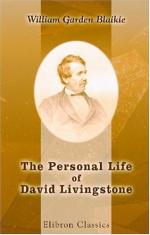[Footnote 43: Virtually a discovery, though marked in an old map.]
[Footnote 44: Afterward ascertained by him to be 1800 yards and 820 feet respectively.]
A discovery as to the structure of the country, long believed in by him, but now fully verified, was of much more practical importance. It had been ascertained by him that skirting the central hollow there were two longitudinal ridges extremely favorable for settlements, both for missions and merchandise. We shall hear much of this soon.
Slowly but steadily the eastward tramp is continued, often over ground which was far from favorable for walking exercise. “Pedestrianism,” said Livingstone, “may be all very well for those whose obesity requires much exercise; but for one who was becoming as thin as a lath through the constant perspiration caused by marching day after day in the hot sun, the only good I saw in it was that it gave an honest sort of a man a vivid idea of the tread-mill.”
When Livingstone came to England, and was writing books, his tendency was rather to get stout than thin; and the disgust with which he spoke then of the “beastly fat” seemed to show that if for nothing else than to get rid of it he would have been glad to be on the tread-mill again. In one of his letters to Mr. Maclear he thus speaks of a part of this journey: “It was not likely that I should know our course well, for the country there is covered with shingle and gravel, bushes, trees, and grass, and we were without path. Skulking out of the way of villages where we were expected to pay after the purse was empty, it was excessively hot and steamy; the eyes had to be always fixed on the ground to avoid being tripped.”




